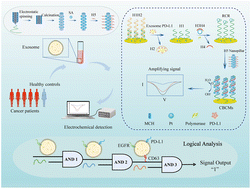Coaxial dual-path electrochemical biosensing and logic strategy-based detection of lung cancer-derived exosomal PD-L1†
Abstract
Exosomal programmed death ligand-1 (ExoPD-L1) is a vital marker of immune activation in the early stages of tumor therapy and it can inhibit anti-tumor immune responses. However, due to the low expression of ExoPD-L1 in cancer cells, it is difficult to perform highly sensitive assays and accurately differentiate cancer sources. Therefore, we constructed a coaxial dual-path electrochemical biosensor for highly accurate identification and detection of ExoPD-L1 from lung cancer based on chemical–biological coaxial nanomaterials and nucleic acid molecular signal amplification strategies. The measurements showed that the detected ExoPD-L1 concentrations ranged from 6 × 102 particles per mL to 6 × 108 particles per mL, and the detection limit was 310 particles per mL. Compared to other sensors, the electrochemical biosensor designed in this study has a lower detection limit and a wider detection range. Furthermore, we also successfully identified lung cancer-derived ExoPD-L1 by analyzing multiple protein biomarkers expressed on exosomes through the “AND” logic strategy. This sensor platform is expected to realize highly sensitive detection and accurate analysis of multiple sources of ExoPD-L1 and provide ideas for the clinical detection of ExoPD-L1.

- This article is part of the themed collection: Theranostic nanoplatforms for biomedicine


 Please wait while we load your content...
Please wait while we load your content...